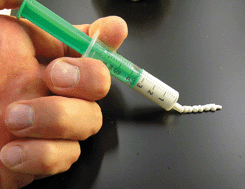Effect of particle size, crystal phase and crystallinity on the reactivity of tricalcium phosphate cements for bone reconstruction†‡
Abstract
The development of injectable bone cements requires a detailed understanding of the reactivity of tricalcium phosphate (TCP)-based cements. The present study systematically investigates a broad set of materials with varying particle size, crystal phase and degree of crystallinity prepared by solid state reaction or flame spray synthesis and sintering. Amorphous TCP nanoparticles of 13, 19 and 40 nm particle diameter were highly reactive and set to calcium deficient hydroxyapatite (CDHA) within minutes. A pronounced increase in reactivity was observed for smaller nanoparticles while the total energy release during setting was constant. The use of α- or β-TCP as starting material confirmed the importance of phase composition in determining cement reactivity. These crystalline phases were much less reactive or even inactive and showed a pronounced influence of the preparation method. The experimentally measured kinetics was used to formulate a physical model of the cement setting reaction based on the shrinking core model. This detailed theoretical understanding of the cement setting processes can now assist the development of injectable cements for minimally invasive orthopedic surgery.

- This article is part of the themed collection: Biomedical materials

 Please wait while we load your content...
Please wait while we load your content...